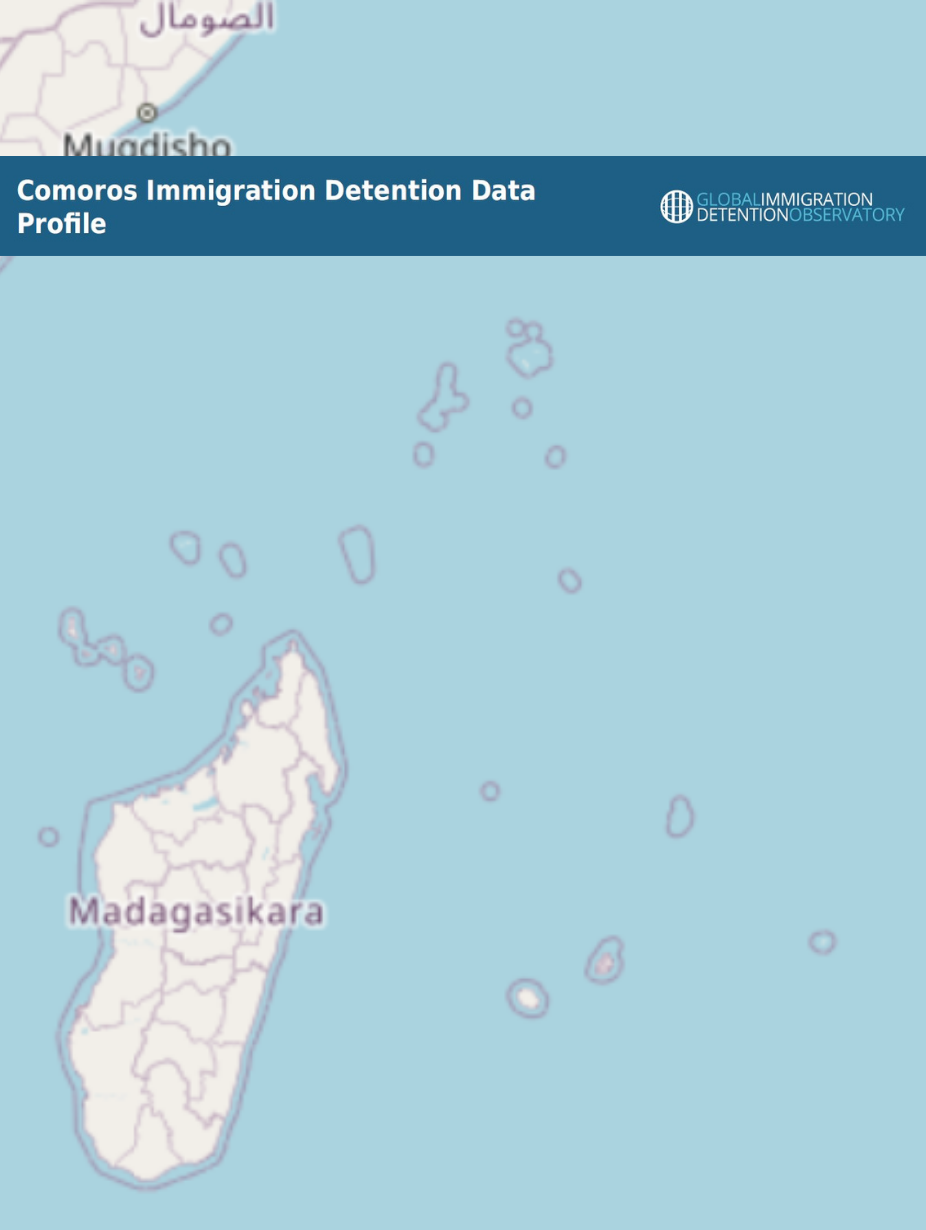Comoros is a small country comprising a set of islands off the southeast coast of Africa, located between Madagascar to the east and Tanzania to the West. It also shares maritime borders with Mozambique, Seychelles, and the French overseas territory Mayotte. One of the smallest countries in the world, with an estimated population of less […]
Read More…
Last updated:
DETENTION CAPACITY
ALTERNATIVES TO DETENTION
ADDITIONAL ENFORCEMENT DATA
SOCIO-ECONOMIC DATA & POLLS
Group
In Law
In Practice
Year
INTERNATIONAL TREATIES & TREATY BODIES
Ratification Year
Observation Date
CAT, Convention against Torture and Other Cruel, Inhuman or Degrading Treatment or Punishment
2017
2017
CRC, Convention on the Rights of the Child
1993
2017
CEDAW, Convention on the Elimination of All Forms of Discrimination against Women
1994
2017
ICERD, International Convention on the Elimination of All Forms of Racial Discrimination
2004
2017
CRPD, Convention on the Rights of Persons with Disabilities
2016
2016
> UN Special Procedures
> UN Universal Periodic Review
> Global Compact for Migration (GCM)
> Global Compact on Refugees (GCR)
REGIONAL HUMAN RIGHTS MECHANISMS
Year of Ratification (Treaty) / Transposed (Directive) / Adoption (Regulation)
Observation Date
APRW, Protocol to the African Charter on Human and Peoples Rights on the Rights of Women in Africa (Maputo Protocol)
2004
2004
2017
ACRWC, African Charter on the Rights and Welfare of the Child
2004
2004
2017
ACHPR, African Charter on Human and Peoples Rights
1986
1986
2017
HEALTH CARE PROVISION
Unsanitary/inadequate detention conditions
Inadequate food or water provision
COVID-19
Comoros is a small country comprising a set of islands off the southeast coast of Africa, located between Madagascar to the east and Tanzania to the West. It also shares maritime borders with Mozambique, Seychelles, and the French overseas territory Mayotte. One of the smallest countries in the world, with an estimated population of less than 900,000, Comoros is nevertheless a source of asylum seekers and international migrants, including in Europe.
Comoros was one of the last countries to record a case of COVID-19, which occurred on 30 April 2020. It reportedly managed to restrict transmission during 2020 by banning international flights from March until September, shutting schools and mosques, and imposing strict curfews and mask obligations. By the end of December 2020, the country had recorded 823 cases and 10 related deaths. Observers have also pointed to poor testing measures and censorship as reasons for the country’s apparently low infection rates. In early April 2020, Reporters Without Borders condemned the prosecution of a local journalist who was reporting on the lack of testing of the first suspected cases on the island, as well as a government’s attempts at censoring independent information on COVID-19.
The situation dramatically worsened in early 2021 as cases rose to 2,834 by mid-March and 136 deaths were reported. The more recent wave has hit the island of Mohéli particularly hard, in part because of the spread of new COVID variants. The island is also isolated from the other islands and lacks medical infrastructure. This has spurred many residents to attempt to travel to neighbouring Mayotte in kwassas-kwassas (speedboats), which as the Global Detention Project has reported has high immigration detention rates (see the GDP’s France Country Report).
In the early stages of the COVID-19 pandemic in March, the usual movements of irregular migrant workers from Comoros to Mayotte reportedly ground to a halt and led to large numbers of people returning to Comoros as workers were unable to find work in the French territory’s agriculture and fishing sectors due to restrictions. Fearing imported cases of COVID-19 from Mayotte, the Comorian authorities started intercepting kwassas-kwassas, detaining people onboard and placing them in quarantine.
Perhaps due to the strict border regime of Mayotte, asylum applications from Comoros nationals rose by 50 percent in Europe during 2020 compared to 2019.
In February 2021, officials announced that the population in the Comoros national prison in Moroni would be cut by 50 percent as a part of a COVID-19 mitigation effort. Photographs published in the media showed the prison’s dormitory packed with many men lying on a cell floor close together, revealing overcrowding in the prison, which housed 200 prisoners with a capacity of around 100. Criticism of prison conditions are long standing. These include reports of dirty, non-ventilated, mouldy and dark cells, infested with cockroaches and rats (F. Soulé Youssouf, 14.09.2020).
Allegations of ill-treatment also persist. In 2019 the UN Special Rapporteur on Torture was refused access to detention sites in Moroni and Anjouan and prevented from interviewing detainees.
The Global Detention Project has been unable to establish whether prisons are used to hold immigration detainees. In October 2014, 7.7 percent of the prison population was made up on foreign citizens for various unreported charges.




